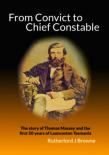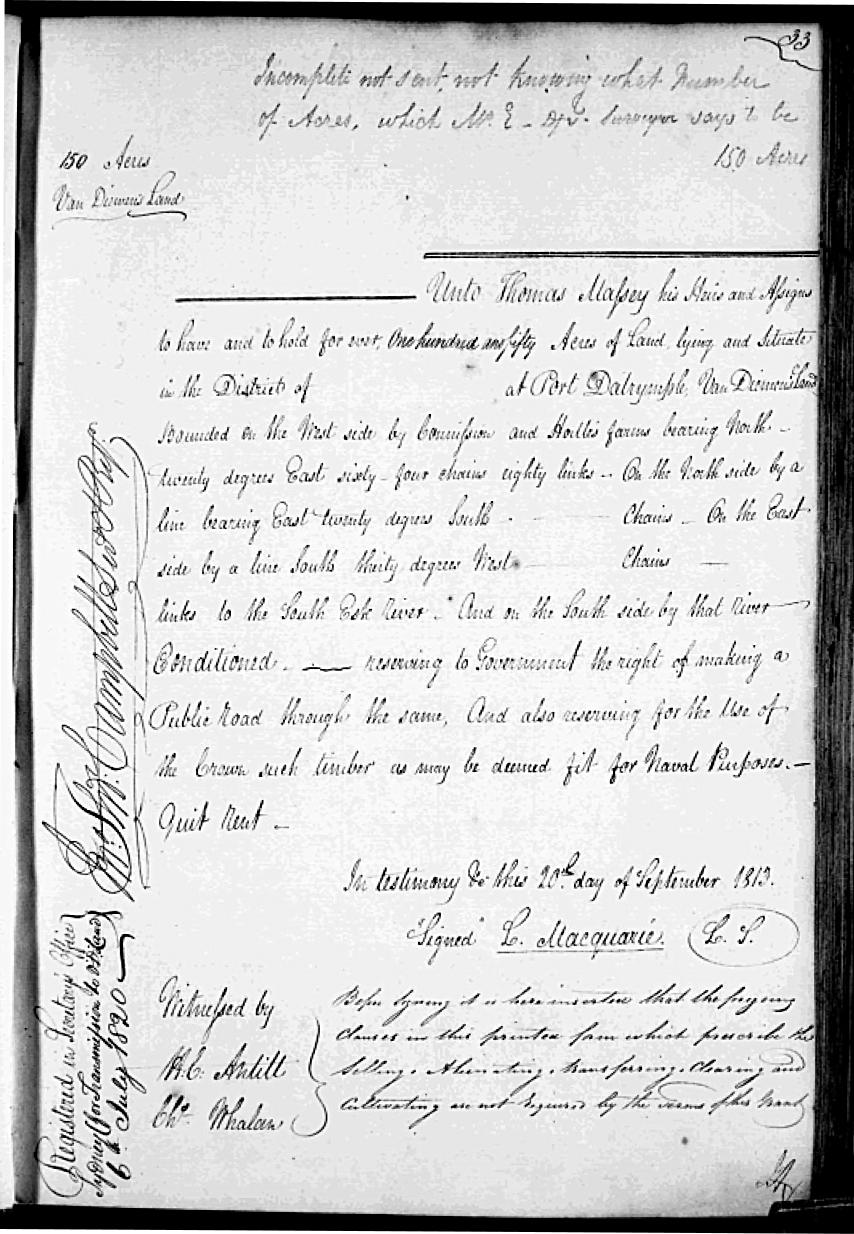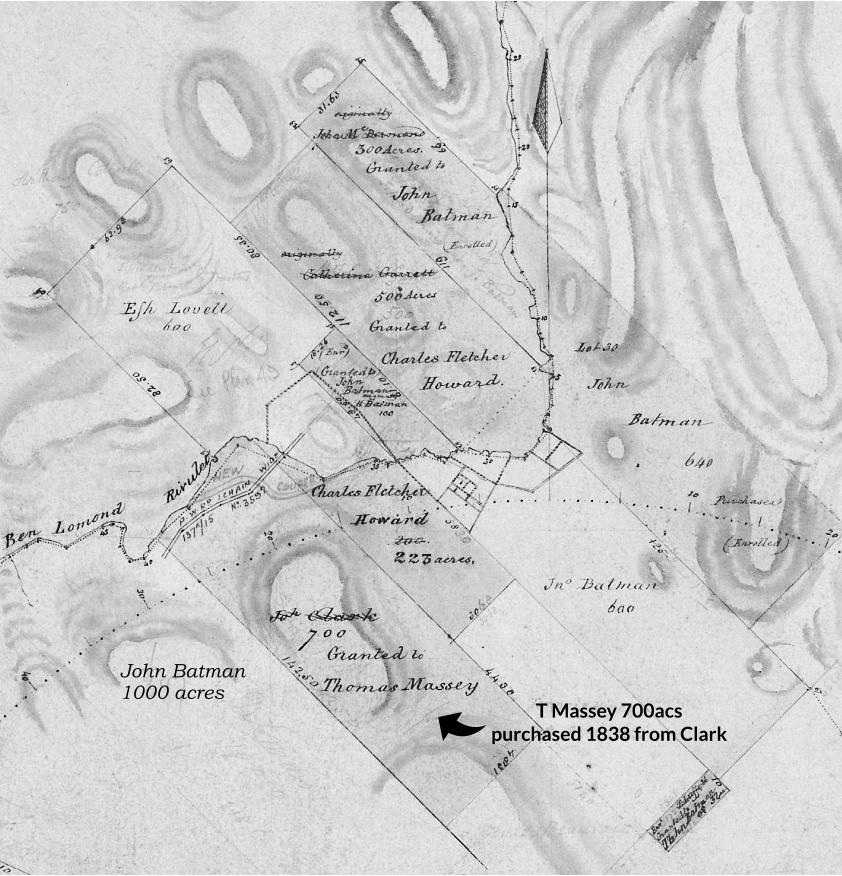The 188 page Reference section contains a range of
additional documentation related to the basic story.
See some examples below.
Example Extracts - Reference Section
From Convict to Chief Constable
The story of Thomas Massey, by Rutherford J Browne

268
269
© Rutherford J Browne 2018
This site and book are protected by copyright. All or parts of it may not be copied or disseminated in any way
without the permission of the copyright owner. You may copy, reference or quote small sections of the work as long
as due acknowledgement is made.

…. …. …. synonymous with the Parish of Malvern a little to the east.
For
the
first
40
or
so
years
of
settlement,
official
documentation
was
often
constructed
on
the
personal
whims
of
the
writer.
There
was
no
well
considered,
pre-defined
data
entry
structure
to
be
followed.
This
led
to
the
same
set
of
circumstances
being
described
in
different
ways
by
different
people.
Property
locations
were
often
imprecise,
their
areas
often
nominal
and
un-surveyed.
It
was
common
for
recorders
to
overlook
critical pieces of information.
The evolution of Land Title recording
Over the full span of Thomas Massey's lifetime, titles were issued and dealt with on the "Old System". For sales, purchases or transfers there was a need to prove a chain of title (i.e. tracing title through a series of documents). As time progressed this became cumbersome and sometimes difficult. Early land dealings were administered and recorded in Sydney. Land allocations and ‘Grant’ paperwork in the early days of settlement can be hard to follow. It often took some years for one to catch up with the other. With Thomas first grants there was no formal structure to record the grants and subsequent dealings like inheritance and sale transfers. To divine exactly what took place, it was necessary to search for administrative notes such as the one at the start of this section. As a beginning, a register was created by the office of the Judge Advocate in Sydney and parties were invited to place their dealings on record. This system was improved by Macquarie, when in January 1817 he issued a proclamation providing for the registration of deeds against the recorded grant documents, to record such events as Transfers of Ownership or Financial Interest and an indexed system of Memorials that recorded in a structured way a summary of the salient facts of the deed. At the close of Governor Thomas Brisbane’s administration in November 1825, the first Registration of Deeds Act came into force and legislated the Supreme Court as the place for the registration of Deeds. “This Act introduced a special form of memorial and the principle that any Deed or instrument executed bona fide and for valuable consideration should take priority according to the date of registration and not of execution. [http://www.lpi.nsw.gov.au/land_titles/land_ownership/old_system] “In order to promote settlement and to deter speculators with fictitious capital, Governor Brisbane, around June 1822, introduced a system that linked the granting of land with the employment and maintenance, free of expense to the Crown, of one convict labourer for every 100 acres (40 ha) they were given.” [ Heydon (1966)] Brisbane only granted land to sons of established settlers if their fathers' properties had been considerably improved. When Sir Thomas Brisbane took over from Macquarie in December 1821 there were 340,000 acres (137,593 ha) of promised grants in the
colony
still
to
be
allocated.
In
addition
there
were
many
confused
permissive
occupancies
and
nebulous
promises.
Lands
were
occupied
and transferred without legal title, and boundary disputes were common.
[Heydon, J. D. (1966)]
June 1823 - The introduction of printed Land Title Deeds
Brisbane made addressing the disorder a priority. A major administrative ‘bottle-neck’ was the time taken to produce the paperwork for each grant. At least two copies were required, one for the Grantee and one for the government records. All this paperwork was hand written. Clerks with a legible hand were not always easy to find and more urgent daily administration often took priority over dealing with the grant recording backlog. Brisbane, or some forward thinking person in his administration, realised a great deal of work could be saved by printing the majority of the wording, leaving blank spaces for the variable content like names and areas. The first printed deeds appeared around June 1823. Early in his term, Brisbane also instituted a program of proper survey and recording as the essential basis for a future workable policy of land alienation.January 1831 - Grants ceased - replaced by purchase
In January 1831 the issue of land grants came to an end. The so- called ‘Ripon Regulations’ were introduced, whereby the granting of crown land within the settled colonies was replaced by auction sales at a minimum of 5s./acre. [ ADB Goderich (1966)].1980 - Tasmanian General Law Title changed to Torrens Title
Throughout the years in Tasmania the basic concept of recording title transactions by deeds remained and was known as a General Law Title . Such a title is considered to be only as strong as the weakest document in the chain of title. It was not until as late as 1980 that The Land Titles Act 1980 (Tas) provided for the compulsory conversion to the Torrens Title system, one that was suited to the coming computer age. A prime example of the confusion generated by haphazard nature of the system was the ignorance, as late as 1887 of the Hobart Supreme Court as to the existence of Thomas Massey’s Brisbane issued ELLERSLIE titles on file in Sydney in the case of Cameron v Massey. See REF03:1887/07/19 and Chapter 10.

272
Appendix 4: Transcripts - J.T.Bigge interviews
Thomas Massey
HRA: Historical Records of Australia Series III. Vol III. Tasmania, January-December 1820. This volume includes the evidence presented to Commissioner Bigge (pp 215-508). RJB NOTE: The published interview content is verbatim including the abbreviations - of the less obvious ones: cd. = could, recd. = received, ch. = chief.C. No. 89. THOMAS MASSEY, Chief Constable at Launceston,
29 April 1820
[HRA 3/3: Document page No. 449] Q. How long have you been Ch. Constable here? A. Since 1804; with the exception of leaves of absence when I have been upon my Farm. Q. What is your Salary? A. I have no salary nor ever had, but for about 18 months I recd. 5 Gallons of spirits quarterly and Two as Water bailiff. Since last December I have recd, nothing but my rations and a man on the Store. My son is likewise victualled from the Store. Q. Do you find that the number of seven Constables is sufficient for the Police of the Town? A. I do not. Two Constables are necessarily placed at the Watch House on account of its bad state and the Difficulty of confining the Prisoners, and, if any woman is confined, she is taken into the out building near the Church, and a constable must watch there. Q. The Messenger is sent with orders and letters to George Town, how often in a week? A. He goes as often as any thing of consequence arrives from the Lt. Govr., otherwise only once a week. Q. Do the District Constables muster the Convicts in their Districts? A. They Inform me they do but they never make a return. I asked for Lists of the Convicts previous to your arrival, but I cd. not obtain any. Q. What is the pay of a District Constable? A. They receive a ration, I dont know to what amount, but no pay. Q. Is there any muster of the Convicts at this Place on Sundays? A. Always. Q. Does any Magistrate attend? A. None. Q. Then who takes the Muster? A. I do myself generally, but, on account of my bad sight, I have sometimes allowed Two of the Constables Page and Smith to muster them. Q. Have you a list of the Convicts that are assigned from time to time to the Settlers? A. I have recd. Lists of the Convicts when they are assigned, but I keep no general List. Q. Why do you not keep one? A. I am not allowed Paper for it, or otherwise I would. …. …. ….
295
313
REF01: TROVE SEARCH - THOMAS MASSEY
Trove search of ALL sources, December 2014 (using www.elephind.com), for massey, for a date range. Entries relevant to the Thomas Massey of interest then manually selected. Entries listed in date order. All spelling, capitalisation and typography left as original. RJB Comments in Italics. Letters following a bracket at the end of an entry ‘eg: (uc’ are an internal newspaper code. The source for all entries is: Trove [National Library of Australia] http://trove.nla.gov.au/ A long listing follows ………………….. REF01:1809/04/16 [Newspaper Article] — The Sydney Gazette and New South Wales Advertiser — 16 April 1809 GENERAL ORDER. - His Honor the Lieutenant Governor has been pleased to appoint Mr. Robert Jones, late Superintendant at Norfolk Island, to be a Superintendant on the establishment at Port Dalrymple agreeable to the direction of the Secretary of State of the 30th of December, 1806, in the room of Thomas Massey, dismissed . HIS HONOR has also appointed Thomas Howard to be a Superintendant and Chief Constable at Port Dalrymple, until further Orders. By Command of His Honor the Lieutenant Governor JAMES FINUCANE, Secretary. Head Quarters, Sydney, April 15, 1809. Publication Title: Sydney Gazette And New South Wales Advertiser, The Country/State of Publication: NSW, Australia REF01:1810/01/21 [Newspaper Article] — The Sydney Gazette and New South Wales Advertiser — 21 January 1810 GOVERNMENT AND GENERAL ORDERS. Head Quarters, Government House, Sydney, Saturday, 13th January, 1810. His Excellency the Governor [ Newly arrived Lachlan Macquarie ] requests Colonel Paterson will cause the Public Accounts, any way connected with, the Periods he commanded in the Colony, to be closed up to the 31st December last, inclusive, as His Excellency judges it irregular to make himself responsible for any Public Transactions which took place prior to his taking upon himself the Administration of the Government. And all Persons holding Government Receipts given by the respective Storekeepers having Charge of the Stores in this Settlement, in Payment for Grain, Animal Food, and Potatoes, or having any other Claims for Purchases made on account of Government, are desired to present them for Payment immediately to the late Acting Commissary (Mr. Broughton),REF04: NSW Colonial Secretary's Papers
1788-1856
Now hosted at www.ancestry.com.au (see link to these papers - free access for these lists). Each result included comment: Per "Gorgon", 1791; Superintendent at Port Dalrymple. Entries edited to remove duplicates.]IMAGE INDEX - Search Thomas Massey
Images in REF order follow. Images of rough notes and single line entries have not been reproduced.‘HISTORICAL RECORDS OF AUSTRALIA’
NOTES ON THE PRINTED VOLUMESConfused? - read this
A major source of original reference material on the early days of Australia can be found in a collection of volumes called “Historical Records of Australia” [HRA]. These volumes comprise the sorted, edited, letters and administration documents of the period. Anyone using these documents is at first stunned by the scope of the content and its ability to transport the reader in time. A deeper look reveals the sporadic nature of this collection, a range of missing volumes and its frustratingly limited publication. It is very hard at first glance to see any order at all in the various ‘snippets’ of the series one encounters. I am truly indebted to the author of an Internet Blog, Janine Rizzetti for the best introduction to the series I have yet found.Blog of Janine Rizzetti
Historical Records of Australia - Posted on August 27, 2011 h t t p s : / / r e s i d e n t j u d g e . w o r d p r e s s . c o m / 2 0 1 1 / 0 8 / 2 7 / t h e - h i s t o r i c a l - records-of-australia/ Following is a transcript of the blog of Janine Rizzetti - published here verbatim, on paper, lest such useful information might one day be lost. The Historical Records of Australia comprise three series of volumes. Within the series, each separate volume is about 900 pages in length, containing transcriptions of the official documentation between the Colonial Office and the local governments in the different states. Series I provides the Governor’s despatches to and from England, Series III contains documents related to the settlement of the states (especially Tasmania) while Series IV which has barely begun, features documents relating to the legal system. Volume 8 of Series III only appeared in 2003, and Volume 9 in 2006. Series II never appeared at all. The early volumes were collected and published by the Library Committee of the Commonwealth Parliament between 1914 and 1925. James Frederick William Watson was the editor. According to his ADB (Australian Dictionary of Biography) entry, he was a medical doctor and historian. He was appointed a trustee, then acting principal librarian at the Public Library of New South Wales. In this position, he inherited the responsibility for transcribing the official New South Wales documents and the papers held in London, a task commenced by F. M. Bladen and James Bonwick separately some years earlier. The Commonwealth agreed to finance the project in 1907 and the project was expanded and retitled as The Historical Records of Australia. This national vision, in the years following Federation is important. Until then, transcriptions of records had been undertaken on a state-by- state basis, largely by James Bonwick who had been contracted … … …BIBLIOGRAPHY
For HRA references, it is useful to read the preceding Notes
ADB Brabyn (1966) Brabyn John (1759–1835) , Australian Dictionary of Biography, National Centre of Biography, Australian National University, h t t p : / / a d b . a n u . e d u . a u / b i o g r a p h y / b r a b y n - j o h n - 1 8 1 8 / t e x t 2 0 8 1 , published first in hardcopy 1966, accessed online 14 August 2016. ADB Cimitière (1966) Cimitière, Gilbert (?–1842) , Australian Dictionary of Biography, National Centre of Biography, Australian National University, h t t p : / / a d b . a n u . e d u . a u / b i o g r a p h y / C i m i t i è r e - g i l b e r t - 1 8 9 5 / t e x t 2 2 3 3 , published first in hardcopy 1966, accessed online 30 July 2016. ADB Goderich (1966) Goderich, first Viscount (1782–1859) , Australian Dictionary of Biography, National Centre of Biography, Australian National University, http://adb.anu.edu.au/biography/goderich-first- viscount-2103/text2655, published first in hardcopy 1966, accessed online 13 September 2016. ADB Mills (1967) Mills, Peter (1786–1816) , Australian Dictionary of Biography, National Centre of Biography, Australian National University, http://adb.anu.edu.au/biography/mills-peter-2458/text3287, published first in hardcopy 1967, accessed online 21 August 2016 ALEXANDER, Alison (2013) The ambitions of Jane Franklin , Crows Nest, NSW Allen & Unwin, ISBN 978-1-74237-569-4 ARTHUR, George (Sir), (1828) Proclamation, 15 April 1828 , British Parliamentary Papers, Colonies, Australia, 4, pp 194–6 BAXTER, Carol J. (1988) Musters and Lists, New South Wales and Norfolk Island, 1800-1802 Sydney : Australian Biographical & Genealogical Record. The ABGR no longer exists, see: www.bda-online.org.au/files/MC1800_Muster.pdf BENNETT, J. M. (1966) Bigge, John Thomas (1780–1843), Australian Dictionary of Biography, National Centre of Biography, Australian National University, http://adb.anu.edu.au/biography/bigge-john- thomas-1779/text1999, published first in hardcopy 1966, accessed online 19 March 2016. BETHELL, Llwelyn Slingsby (1957) The Story of Port Dalrymple, Blubber Head Press, Sandy Bay Tasmania 7005 BIGGE, John Thomas (1822) Report on State of the Colony of New South Wales, http://gutenberg.net.au/ebooks13/1300181h.html Date first … … …
439
Appendix 3
Appendix 3

Appendix 3
290
Map A3/1: Landholdings of Massey, Batman, and C. F. Howard
Shows some but not all of Howards landholdings.
Shows 1838 purchase by Thomas Massey from Clark.
Extract from Sheet 28, Surveyors Notes Parish of St. Aubyn. c1838

See also:
http://stors.tas.gov.au/AF396-1-1362 Field Notes 38Cornwall - Youl
http://stors.tas.gov.au/AF396-1-1374 Hundred of Avooca
http://stors.tas.gov.au/AF396-1-1343 Survey along South Esk river
http://stors.tas.gov.au/AF396-1-1344 TW Massey in trust for C Howard
an orphan 200ac adjacent to Batman 600ac [the W in TW is likely an error]
Appendix 3
Ref
01
02
03
04
05
06
07
08
09
10
Event Date
10 Apr 1802
7 Apr 1804
13 Apr 1809
14 Nov 1809
22 Jan 1810
29 Jan 1810
29 Jan 1810
9 Oct 1810
23 Oct 1810
3 Nov 1810
Event Description
Particulars of arms in possession of.
Subscribed
to
the
rules
and
orders
of
the
Sydney
Loyal Association.
Dismissed
as
Superintendent
at
Port
Dalrymple
-
sketchy partial notes - image not included
On
list
of
all
grants
and
leases
of
town
allotments
registered in the Colonial Secretary's Office.
No.
361,
Nov
14
1809,
Thomas
Massey,
On
the
Rocks
in
the
Township
of
Sydney,
24
rods,
Term
14
years,
Annual
Quit
Rent
5s,
Authorised
Leiut
Gov Wm Paterson, Reg Book 4D p207.
Massey
Memorial
to
Macquarie
request
to
renew
house lease in The Rocks. Image: Text Chpt. 5
To
be
restored
as
Acting
Superintendent
at
Port
Dalrymple.
Written
advance
note
to
Gordon
prior
to his sailing on the
Trial
and Gordon’s reply.
Acknowledgement from Gordon of General Order
No. 45 Massey to be re-instated as
Superintendent in place of Howard.
To
receive
two
cows
and
six
ewes
from
the
Government Herds to be paid for from salary.
Massey
Prosecution
witness
-
4
prisoners
from
Port
Dalrymple
for
sheep
stealing
transmitted
to
Ellis Bent, Judge Advocate Sydney.
Sheep Stealing Trial - outcome - consequences -
Massey appointed Superintendent of
Government Stock - to receive 150acs land. … …
417